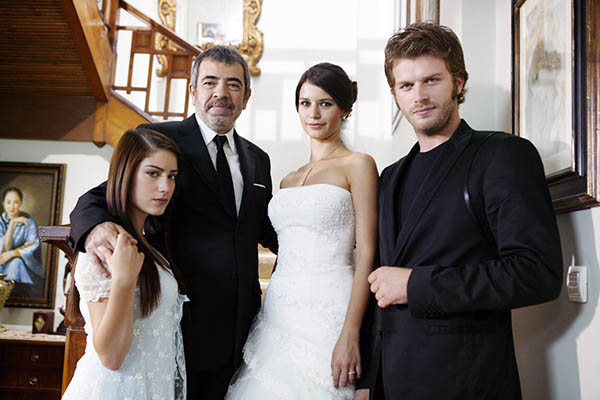
A publicity image from Turkish drama Ishq-E-Mamnu
Navid Shahzad’s new book delves into the abiding popularity in Pakistan of television imported from Turkey
India was “transformed” by the British Raj; and this “deviation” called “modernization” gave it new ways of looking at the world and at itself. It got divided in 1947, but retained the afterglow of this enlightenment-through-subjugation. Gandhi and Nehru created the new secular state; Ambedkar gave it a secular constitution—till Narendra Modi burst on the scene. Jinnah dreamed of a secular Pakistan but the new state soon succumbed to “ideology” and Islamization rolled back his dream. It all began in Turkey, however, whose leader Kemal Attaturk “modernized” a “Khilafat” state that had begun to be called the Sick Man of Europe.
These days Pakistani television leans heavily on entertainment to distract Pakistanis from the burdens of ideology and, among other foreign borrowings, shows a lot of dubbed Turkish drama. Needless to say, the Turkish contribution to Pakistani entertainment is quite popular. And it is not surprising: Turkey sold 135,000 drama hours to 75 countries in 2015, generating approximately $300 million, which was surpassed by the $350 million earnings in 2017.
A book—perhaps the first of its kind—has come out in Pakistan looking analytically at the phenomenon. On the face of it, Turkish drama is pure entertainment with pretty girls clad in miniskirts and tights falling in love with strapping Turkish boys as, for instance, in Golden Butterflies, which is currently being broadcast on Pakistani channels. But the book delves deeper into the whole phenomenon of modernization/westernization in Turkey and how it carries within it cultural values that are purely Turkish and appeal to audiences in Pakistan.
The writer of the book, Aslan’s Roar: Turkish Television and the Rise of the Muslim Hero (2019), is Navid Shahzad, herself a legend in Pakistan in the fields of show business and higher education. Obtaining her Master’s from the Government College Lahore with a Roll of Honor, she became a person of theater, beautiful and richly talented as an actor. After leaving her teaching job at the Punjab University in 1996, she wrote poetry in English, Urdu and Punjabi, contributed a weekly column to a mainstream English daily, and acted on television, while guiding her three children through college and university, heading a fashion institute, and helping found a liberal arts university.
A keen follower of Turkish TV drama, Shahzad got deeper into it after she fell ill and was “addressed” while in delirium by her favorite Turkish actor Engin Akyurek: “Come! We are all waiting for you!” The result in 2019 is her well-produced book on the phenomenon that is worth $3 billion of TV ads in Turkey today.
Turkey may be fighting Kemalism but the rights “modernization” has bestowed on women can’t be taken away easily; and President Erdogan is wise enough to not upset the great tradition still radiating from television: “This forceful top-down approach created a class of political elite which embraced an active, rapidly moving reformist trajectory congruent with the pace demanded by modernization.” The book notes how Attaturk adopted and educated a number of girls, prominent among them being Sabiha Gokchen—Turkey’s first woman fighter pilot after whom one of Istanbul’s airports is named.
Author Shahzad also takes note of the “reaction” to “modernization” in Turkey, as elsewhere in the Muslim world: the upending of the vision of Jinnah in Pakistan based somewhat directly on the example of Turkey as Jinnah avidly read the biography of the great Turkish leader; and the less relevant “reaction” through Narendra Modi in India to post-Raj “enlightenment.” For Shahzad, the inspiration came through Faiz Ahmed Faiz and Faiz’s favorite Turkish poet, Nazim Hikmet.
She writes: “At present, Turkey’s status as a modern, Muslim, secular Republic with its ideologically polarized and segmented society remains contested; even as it offers an intriguing comparison with issues similar to those being faced by an equally polarized Pakistan still trying to recover from an anti-secular, rigid Islamist agenda perpetrated by a military dictatorship which created deep schisms within the body politic of Pakistani society. It is in this context, that the content of present day Turkish TV series appears to wedge itself, i.e., between the binary opposites of an Ottoman past, and a modern secular society in what are obviously thinly disguised, semi-symbolic narratives. This has resulted in an intriguing hybridity constructed by the presence of perceived commonalities rather than the differences between ideologies to tell contemporary stories.”
